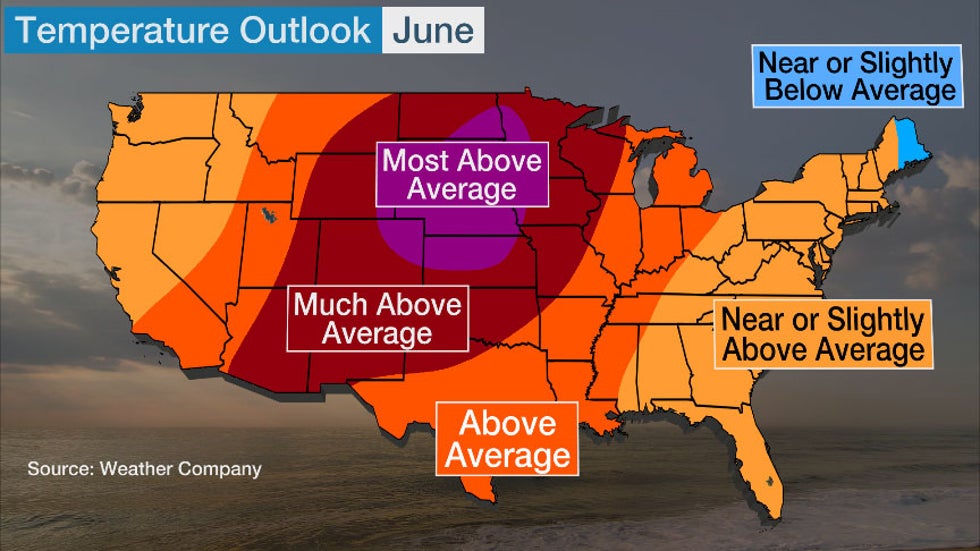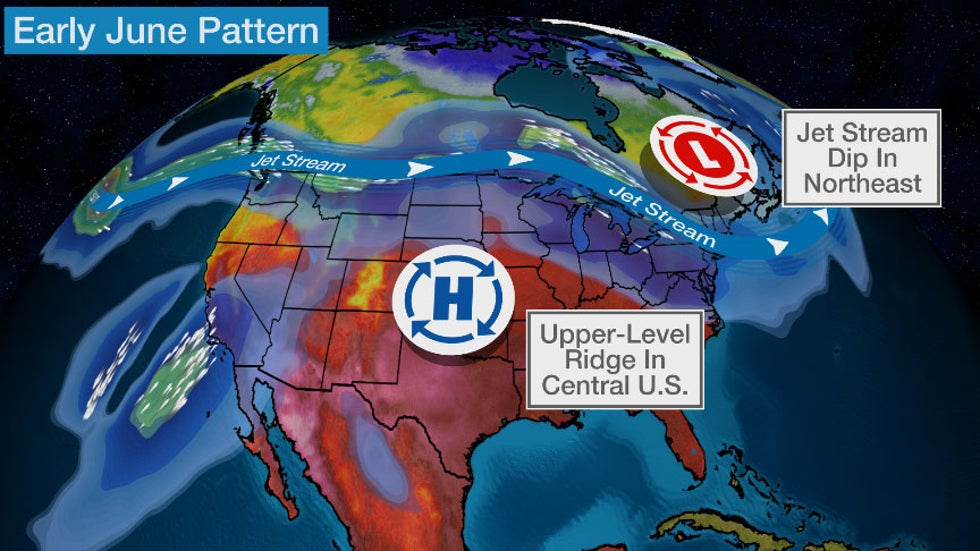An unusually hot June is expected across the central U.S., while the East and areas toward the Northwest will likely trend closer to average, according to the latest update from The Weather Company, an IBM Business.
Above-average temperatures are anticipated from the Southwest through the Rockies and Plains into the Mississippi Valley and Great Lakes region. Temperatures will be the most above average from northeastern Colorado and southwestern Wyoming into western Minnesota and southeastern North Dakota.
The Southeast and Northeast are expected to experience temperatures near or slightly above average, with the exception of eastern Maine, where slightly below-average temperatures are possible. Farther west, temperatures from Central California into the Northwest will also likely be near to slightly above average for the first month of meteorological summer.
 June 2020 temperature outlook from The Weather Company, an IBM Business.
June 2020 temperature outlook from The Weather Company, an IBM Business.Temperatures have overall been cooler than average in much of the East and Midwest for April and May, but a change to warmer conditions is expected in June. Such a switch is often the case in the Northeast.
"Since 1950, the temperature anomaly in June in the Northeast has been the opposite sign of that in May 61% of the time," according to Dr. Todd Crawford, chief meteorologist at The Weather Company.
This suggests a cooler-than-average May is more likely to be followed by a warmer-than-average June. In addition, only three of the last 15 years had a cold May in the Northeast, and those years had a notable flip toward hot conditions in June, Crawford noted.
This June will start with a southward dip in the jet stream over the Northeast. This will allow cooler conditions to return to the region after several days of heat and humidity in late May. However, temperatures overall for June will likely be closer to average, especially compared to the last two months in the Northeast.
(MORE: A Taste Of Summer Will End May in Parts of the West, Great Lakes and Northeast)
The weather pattern in early June will feature a ridge of high pressure over the Plains and result in a hot start to the month from the Rockies into the Midwest.
 Expected Pattern in Early June
Expected Pattern in Early JuneAnother factor in summer temperatures is soil moisture, which remains high from the north-central U.S. into the mid-Atlantic and Southeast. Higher soil moisture often correlates with cooler conditions, but significant drying has happened this spring in parts of the northern tier. This trend is expected to persist into the summer and suggests a slightly warmer summer than last year in the north-central United States.
In addition, conditions in the equatorial tropical Pacific suggest a transition to La Niña. When this happens in the middle of the year, a warmer-than-average summer typically occurs in the Lower 48.
Average June Temperatures
Meteorological summer begins June 1. Highs average in the 70s for much of the northern tier, with widespread 80s from the mid-Atlantic and Southeast into the Central Plains and the Great Basin. Temperatures typically top out in the 90s for much of the southern tier.
The central U.S. is expected to experience above-average temperatures in June. Meanwhile, generally mild to warm conditions may dominate the Northeast and Northwest, given the forecast for temperatures to be near to slightly above average in most of those regions.
 Average Highs in June
Average Highs in JuneAverage lows in the 60s become more common east of the Rockies in June, while temperatures continue to dip into the 30s and 40s in the Northwest, northern Rockies, northern Great Lakes and far northern New England.
Warmer-than-average lows suggest temperatures may only fall into the 60s and 70s for much of the Lower 48 in the month ahead.
 Average Lows in June
Average Lows in JuneThe Weather Company’s primary journalistic mission is to report on breaking weather news, the environment and the importance of science to our lives. This story does not necessarily represent the position of our parent company, IBM.
The Weather Company’s primary journalistic mission is to report on breaking weather news, the environment and the importance of science to our lives. This story does not necessarily represent the position of our parent company, IBM.

No comments:
Post a Comment